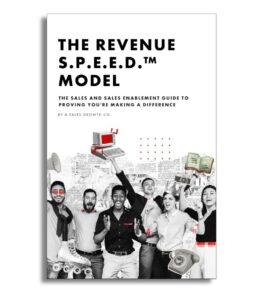This information, the answer to this question, is buyer input data.
Buyer Input Data
Buyer input data is the specific and unique data & information from the buyer that proves that the cost of inaction is greater than cost of action.
It’s not the buying process, or the budget, or the timing, or economic buyer, or any of the traditional criteria. Buyer input data is the critical problem elements the buyer explicitly shares with the rep, (not guessed by the rep or inferred, but specifically told to the rep from they buyer) that highlights the cost of not changing in comparison to changing.
What makes this data so important is it provides both the buyer AND the salesperson with a clear understanding of what’s happening in prospect’s current environment to assist them in understanding if they need to change or if they can continue as is.
Sales is About Change
People do not change unless their current state is untenable or intolerable. Therefore understanding what issues are most present in an organization, BEFORE YOU ARRIVE, that suggest or demand change is critical and game changing when properly identified.
Let’s Say You Sell Gym Memberships
What do we know about people who are considering gym memberships? Why would someone decide they need to pay for access to a gym? If you’re like most people, your first thought was, because they don’t have gym equipment, or they don’t have a place to work out, etc. And on the surface, this makes sense, but when we think about it a little deeper, these are just root causes to a bigger problem. They aren’t enough to change.
So what is enough to make someone change, i.e. buy a gym membership?
There are many:
- The person has gained a lot of weight and:
- Is no longer confident in their appearance and doesn’t feel confident dating
- They may be pre-diabetic and concerned they could get diabetes putting their life in danger
- They may be at risk for cardiovascular disease and feel they are at risk for heart attack
- They are angry at themselves for letting themselves go and can’t find the motivation to workout and afraid they will continue to put on weight and become pre-diabetic or increase their risk of heart disease
- The person has committed to a bucket list event (Marathon, Ironman, Spartan Race, etc.) and
- Knows they can’t complete the event now and are afraid of failing
- Has a personal goal and are afraid they won’t make it
- Are afraid they won’t finish and are afraid of being humiliated
- The person lacks energy and finds themselves lethargic and
- They don’t have the energy to spend with their kids/family and they’re afraid of losing more valuable time with their family
- They aren’t as productive at work and are concerned they won’t get that promotion or worse could get fired
- They find themselves feeling depressed and not spending as much time being social and doing the things they love.
If you sell gym memberships how much better positioned do you believe you would be if you got the buyer to share this level of information. How much better positioned would you be if your buyer opened up and shared with you the detailed elements of any of these? Sales managers, how much more confidence would you have if your sales rep was able to uncover this level of information with even more specificity?
Imagine you or your salesperson uncovers that the prospect is pre-diabetic, and has put on 100lbs in the past 3 years, that they’re recently divorced, and now single after 9 years and has zero confidence in their appearance. Imagine they share that they have no children and desperately wanted to start a family. Add to this, that they’ve tried YouTube videos and home workouts, but they just weren’t sticking to them. Imaging getting all of this information, how much more confident would you be in closing this deal?
This is buyer input data and it’s the key to every sale. What makes buyer input data even more powerful is you can know what it is and what you’re looking for before you even start talking with prospects.
Document and Learn Buyer Input Data
What makes buyer input data so powerful is you can know what it is BEFORE you start engaging with buyers and therefore it’s critical to do the work upfront. Documenting buyer input data requires stepping back and evaluating what problems do my prospects have, currently, that my product or service solves? Let me repeat that, what problems do my prospects have, currently, that my product or service solves?
Then ask yourself, if this problem exists, what are the impacts to the organization or person? As in the gym examples, the problem was weight gain, the impacts were high risk of heart attack, not starting a family, or not spending enough time with your family, etc. Then ask yourself, why do the problems exist, what’s causing them? This exercise will allow you to see ahead of time, before you or your team even begin engaging with prospects, what information you should be gathering to understand if the buyer should change.
Documenting the buyer input data you must get from your prospects increases your ability to close deals and, just as importantly, understand which deals have a higher probability of closing. Using our gym example, if you have two prospects, one has put on 100 pounds, can’t get to their kids soccer games, is no longer able to play with them, is recently divorced, so they only get them part time and another customer who made a New Years Resolution to lose 10 pounds, which do you think has the higher probability to close? Exactly!
All the information you need to win a deal should come from your buyer and the more you understand it, know what to get, and how to get it, the more successful you and/or your team will be.
Buyer input data is at the core of EVERY sale whether you’re aware of it, can access it, or have already obtained it.
Go through the exercise and document what information you or your team HAVE to get in order to know that an opportunity is a good opportunity. Once you’ve done this, memorize the information, post it where you can see it everyday, create fields in the CRM to capture it, and make sure management is assessing it and providing feedback around. Build it into your sales process and your forecasting process.
Not all deals are created equal. Just because a buyer says they want to buy doesn’t mean they will. It all comes down to: is the cost of inaction greater than the cost of action and that’s driven by buyer input data!
Are you getting the buyer input data you need to win deals? — You should!




0 Comments